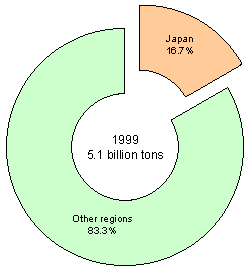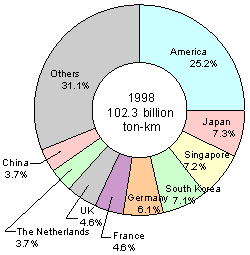| 5. As for international transport, with Japan being an island country surrounded by ocean and a low amount of natural resources, we import a large amount of foodstuff and raw materials and as a product export country; we have expanded the interaction we have with other foreign countries. The demand for international cargo has increased rapidly in conjunction with our economic growth. In response, the construction of international airports and seaports has advanced. |
| Worldwide Sea Cargo Volumes | Worldwide International Air Cargo Volume Handled |
 |
 |
||
| Source: Created from the Ministry of Transport "Current Conditions of Japan's Sea Cargo-2000" |
Source: Created from the ICAO "Annual Report of Council-1998" |
| 6. During this time, Japan's current transport systems support a population of 126 million citizens and an enormous amount of economic activity that surpasses 500 trillion yen per annum. Furthermore, it has made a large contribution to regional development. While the transportation network continues to through the infrastructure of airports, seaports and a nationwide railway system, transport bottlenecks still remain in the major metropolitan areas. |
|
| 7. Conversely, the necessity to consider the entire transportation system as a comprehensive structure that collaborates within itself was pointed out in this council's 1971 and 1981 reports. At the time of these reports the increase in transport capacity in all modes of transportation was a major issue, however there were very few concrete policies that produced any solid results. Additionally, responses to the burden placed on transport through road congestion, environmental issues and traffic accidents etc. were conducted separately, and the policies that tried to solve the problems that existed within the comprehensive transport system as it was seen were not sufficient. |
|
|
PREVIOUS |
|
TOP |
|
